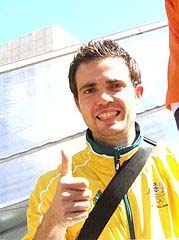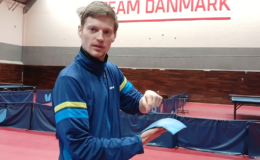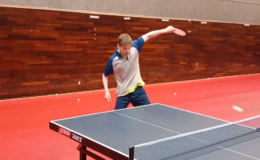New ITTF regulations require new design for non-celluloid plastic table tennis ball:
The ITTF has ruled that in 2014 the official table tennis ball for ITTF events must be made of non-celluloid material. The ball manufacturers are hard at work producing the best possible ball to meet the new ITTF regulations. The design process takes some time, as this affects the future of our sport. A few proto-type balls have been given to a select few top level players and coaches. Here is a video from William Henzell giving his impressions of the test ball he received at the 2012 World Championships in Dortmund. The text from his video is also transcribed below:
Review from William Henzell for new plastic ball:
I received a few packs of the latest version of the new plastic balls from Wang Liqin at the World Team Championships in Dortmund last week. They were brand new and were the best that manufacturer Double Happiness has come up with yet. Everyone is curious about the new balls. How differently will they play? Will there be less spin? Are they going to be faster or slower? So apart from some interesting marketing, I think it may have been lost in translation, let’s have a look at how the new balls fared.
The first thing you notice is the different sound. They sound broken. As it turned out, this would be tested in a few minutes time. The bounce feels different and generally higher. The height and speed of the bounce was less dependent on the spin the player puts on the ball. It sort of evens out the effect of the spin. We predicted that it would be easier to hit harder and more through the ball against long backspin pushes as the ball will sit up higher. The bounce will take some getting used to. The ball will be in a different position than we are used to and are expecting. Not easier nor harder, just different. Tens of thousands of hours of training will have to be re-worked to start expecting the ball to act differently.
We found there was less spin generally. On the sidespin loops I was doing, the ball would be curling off to the side with the old balls. Now the ball went in a pretty straight line as there was just less spin on it. Our wobble test didn’t go too well. It’s a common test that players do to evaluate the roundness of balls. The balls wobbled from side to side when spun, which means that it just isn’t round enough. We all hope this will improve. I felt the ball played pretty similarly to the old celluloid balls with a few differences. The new balls are definitely harder. They feel uniformly hard in every place around the ball, which you very rarely find in celluloid balls. This should mean a more consistent and better bounce. The new balls feel heavier, although they are supposed to be the same weight as the old balls. I think this probably has to do with the hardness of the ball. There is less give when you hit the ball, so that means you need to put more effort to get the same effect on your shot, thus making them feel heavier.
Something we’d all wondered is how durable will the balls be? If they sound broken all the time, how will you know when they actually are broken? Also, without a seam to break on like balls always do now, what will it look like when a ball does break? We soon found out. After just several minutes of play, we had our first broken ball. The ball sounded even more broken than it should, and sure enough there was a one to two centimeter crack across the ball. I remember when one of the major table tennis manufacturers tried to make their celluloid balls harder to get more consistent bounces and it was a complete failure. The balls broke so quickly that it didn’t really matter if they bounced marginally better. Manufacturers will have this same problem with the new plastic balls. It won’t be just a matter of making the balls harder as it will make them break faster, so I think this will be a long development process. Whilst we did think that the ball spins less there is certainly still spin on it, and it feels different too. It feels heavier in some cases because the ball feels harder and heavier like it is more difficult to get it moving.
As the ball moves through the air and bounces differently, certain shots will feel like they have more spin and certain shots will be surprisingly low on spin. It’s quite confusing now as our brains are programmed to the old balls, but I think players will adjust quickly. Like this shot here—it drops straight off Martin’s racket as, a) he was expecting more spin, and b) he was expecting the ball to sink more into his rubber and racket. His comment here was, “It didn’t even make it to the net”.
Our coach, Richard Prause, was late to lunch but couldn’t resist having a go with the plastic balls. He is famous for having possibly the world’s spinniest slow forehand topspin of all time, so he knows a thing or two about spin. He felt that there will definitely be less spin than before. His first impression is that blocking will be easier as the ball will sit up higher and have less spin, but the counter-spin may be easier or more difficult, it’s just too hard to tell.

William Henzell
Bio for William Hetzel:
William Henzell represented Australia at 8 World Championships and at the Olympics in 2004 & 2008. He secured Australia’s first Commonwealth Games table tennis singles medal with a silver medal at the 2006 Commonwealth Games. His highest international ranking was 108 in 2010.



